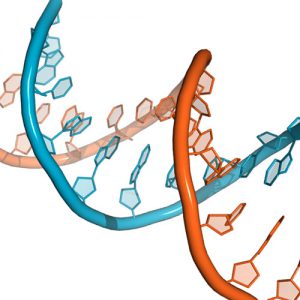Silence is Golden – The Power of siRNAs
What is siRNA?
 Short interfering RNAs, sometimes referred to as silencing RNAs or siRNA for short, are a common tool to induce transitory suppression of coding genes. In 1928, the Plant Pathology head at Virginia Tech, SA Wingard, noticed that as tobacco plants infected with ringspot virus continued to grow, their outer leaves showed signs of resistance to the virus[1]. We know now that this resistance was mediated by an immune response that generated double-stranded RNAs which were used to target specific mRNAs in the plant cells. siRNAs were more formally described in C. elegans in 1988 by Craig Mello, in plants in 1999 by David Baulcombe’s group, and later in mammals by Thomas Tuschl.
Short interfering RNAs, sometimes referred to as silencing RNAs or siRNA for short, are a common tool to induce transitory suppression of coding genes. In 1928, the Plant Pathology head at Virginia Tech, SA Wingard, noticed that as tobacco plants infected with ringspot virus continued to grow, their outer leaves showed signs of resistance to the virus[1]. We know now that this resistance was mediated by an immune response that generated double-stranded RNAs which were used to target specific mRNAs in the plant cells. siRNAs were more formally described in C. elegans in 1988 by Craig Mello, in plants in 1999 by David Baulcombe’s group, and later in mammals by Thomas Tuschl.
Using the cell’s own machinery, siRNA will knock down expression of a particular target protein without disrupting the corresponding gene itself. Each siRNA is double-stranded with a “sense” and “anti-sense” strand, is 19-25 nucleotides long and contains a 5’ phosphate group and a 3’ hydroxyl group to help the cell recognize it. Knocking down proteins using this method enables researchers to uncover the role of a protein or a protein complex in a normal versus aberrant state. It can also be used to identify new drug targets for various diseases.
How does siRNA work?
siRNAs take advantage of the central dogma of biology (DNA → RNA → Protein) by interfering with the ability of a cell to translate RNA into protein. Depending on the cell line, scientists deliver siRNAs to the cell either by encasing them in lipids, which are easily taken up through the cell membrane, or by electroporation, essentially electrocuting the cells until tiny holes form in the membrane.
After the siRNA enters the cell, it is recognized by an enzyme called Dicer. Dicer splits the RNA strands and loads the “anti-sense” strand onto an RNAi-induced silencing complex (RISC). Using the “anti-sense” strand for guidance, the RISC complex then finds a complementary target messenger RNA and cuts it. Because it is no longer intact, the cell recognizes that the mRNA is damaged and will continue to degrade it. The mRNA is destroyed before it can enter translation and build a protein, so the target protein is effectively silenced. Unlike with CRISPR, the target gene itself is left intact and will continue to transcribe mRNA. As cells continue to divide, the siRNA gets diluted out and eventually loses its silencing effects.
What are the advantages and disadvantages of using siRNA compared to other gene silencing methods?
Advantages
- siRNA transfections are easy to do. Lipid-based transfections are fast, with 5-20 minutes of hands-on time, and electroporation instruments come pre-programmed for a variety of cell types.
- The knockdown occurs within 48 hours, allowing rapid assessment of any functional effects, such as changes in proliferation or cellular signaling.
- siRNAs are cheap and usually ship quickly from a variety of vendors.
Disadvantages
- This method can cause unintended knockdown of other genes aside from the target gene. Sometimes the passenger, or “sense” strand, is loaded onto RISC instead of the guiding “anti-sense” strand. This can guide RISC to target other mRNAs, called “off-targets”.
- The knockdown is transient, so effects of total protein ablation cannot be used by this method.
- Cells need to be amenable to lipid-based transfection or electroporation. Some difficult-to-transfect cells, like primary cells, are not compatible with these techniques.
Despite these disadvantages, for many experiments, siRNAs provide a useful tool for silencing target proteins. If you’re studying transcription or translation, the Kerafast catalog offers a variety of reagents for gene expression research, direct from academic laboratories worldwide. Related products include:
- Argonaute-2 (AGO2) Antibody: detect Ago proteins, which bind siRNA and microRNA with RISC
- CAN-Fe2O3 Nanoparticles: shown to be useful for siRNA-mediated gene silencing applications
- dsRNA Antibody: recognize double-stranded RNA (dsRNA) greater than 40 base pairs in length
- Puromycin Antibody: provides a non-radioactive method to measure global protein synthesis (mRNA translation)
[1] Wingard SA. Hosts and symptoms of ring spot, a virus disease of plants. J Agric Res. 1928;37: 127-153.


